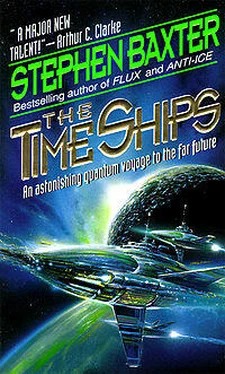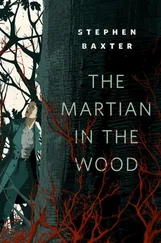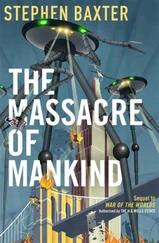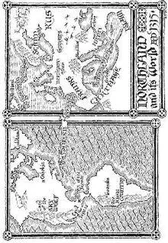In the manner of a cricket stroke, I swung my makeshift club — thump — into Diatryma’s head. The blow was softened by feathers and flesh, but I felt a satisfying collision with bone.
The bird opened its beak, dropping the Morlock, and squawked; it was a noise like sheet-metal tearing. That huge beak was poised above me now, and every instinct told me to run — but I knew that if I did we should both be done for. I raised my wrench back over my head, and launched it towards the crown of the Diatryma’s skull. This time the creature ducked, and I caught it only a glancing blow; so, after completing my swing, I lifted up my wrench and smote against the underside of the beak.
There was a splintering noise, and Diatryma’s head snapped back. It reeled, then it gazed at me with eyes alight with calculation. It emitted a squawk so deep-pitched it was more like a growl.
Then — quite suddenly — it shivered up its black feathers, turned, and hobbled away into the forest.
I tucked the wrench into my belt and knelt beside the Morlock. He was unconscious. His leg was a crushed, bloody mess, the hair on his back soaked by the bird-monster’s looping spittle.
“Well, my companion in time,” I whispered, “perhaps there are occasions when it is useful to have an antique savage on hand, after all!”
I found his goggles in the mulch, wiped them clear of leaves on my sleeve, and placed them over his face.
I peered into the forest’s gloom, wondering what I should do next. I may have traveled in time, and across space to the Morlocks’ great Sphere — but in my own century, I had never journeyed to any of the Tropical countries. I had only dim recollections of travelers’ tales and other popular sources to guide me now in my quest for survival.
But at least, I consoled myself, the challenges that lay ahead would be comparatively simple! I would not be forced to face my own younger self — nor, since the Time-Car was wrecked, would I have to deal with the moral and philosophical ambiguities of Multiple Histories. Rather, I must simply seek food, and shelter against the rain, and to protect us against the beasts and birds of this deep time.
I decided that finding fresh water must be my first mission; even leaving aside the needs of the Morlock, my own thirst was raging, for I had had no sustenance since before the shelling of London.
I placed the Morlock in the midst of the Time-Car’s wreckage, close to the tree trunk. I thought it as safe a place as anywhere from the predations of the monsters of this Age. I doffed my jacket and placed it under his back, to protect him from the moisture of the mulch — and anything that crawled and chewed that might live therein! Then, after some hesitation, I took the wrench from my belt and laid it over the Morlock, so that his fingers were wrapped around the weapon’s heavy shaft.
Reluctant to leave myself weaponless, I cast about in the car’s wreckage until I found a short, stout piece of iron ribbing, and I bent this sideways until it broke free from the frame. I hefted this in my hand. It did not have the satisfying solidity of my wrench, but it would be better than nothing.
I decided to make for that sound of water; it seemed to lie in a direction away from the sun. I rested my club on my shoulder and struck out through the forest.
It was not difficult to make my way, as the trees grew from loose, mixed stands, with plenty of level earth between; the thick, even canopy of leaves and branches excluded the light from the ground, and seemed to be suppressing growth there.
The canopy swarmed with vigorous life. Epiphytes — orchids and creepers — clung to the trees’ bark surfaces, and lianas dangled from branches. There were a variety of birds, and colonies of creatures living in the branches: monkeys, or other primates (I thought, at that first glance). There was a creature something like a pine marten, perhaps eight inches long, with flexible shoulders and joints and a rich, bushy tail, which scampered and leapt through the branches, emitting a cough-like cry. Another climbing animal was rather larger — perhaps a yard long — with grasping claws and a prehensile tail. This did not flee at my approach; rather it clasped the underside of a branch and peered down at me with unnerving calculation.
I walked on. The local fauna were ignorant of man, but had evidently developed strong preservation instincts thanks to the presence of Nebogipfel’s Diatryma, and no doubt other predators, and they would be wary of my attempts to hunt them.
As my eyes became attuned to the general forest background, I saw that camouflage and deception were everywhere. Here was a decaying leaf, for instance, clinging to the trunk of a tree — or so I thought, until, at my approach, the “leaf” sprouted insectile legs, and a cricket-like creature hopped away. Here, on an outcropping of rock, I saw what looked like a scattering of raindrops, glinting like little jewels in the canopy-filtered light. But when I bent to inspect them, I saw these were a clutch of beetles, with transparent carapaces. And here was a splash of guano on a tree trunk, a stain of white and black — and I was scarcely surprised to see it uncurl languid spider-legs.
After perhaps half a mile of this, the trees thinned; I walked through a fringe of palm trees and into the glare of sunlight, and rough, young sand scraped against my boots. I found myself at the head of a beach. Beyond a strip of white sand a body of water glittered, so wide I could not see its far side. The sun was low in the sky behind me, but quite intense; I could feel its warmth pressing on the flesh of my neck and scalp.
In the distance — some way from me, along the long, straight beach — I saw a family of Diatryma birds. The two adults preened, wrapping their necks around each other, while three fledglings waded about on their ungainly legs, splashing and hooting, or sat in the water and shivered moisture into their oily feathers. The whole ensemble, with their black plumage, clumsy frames and minuscule wings, looked comical, but I kept a careful eye on their movements while I was there, for even the smallest of the youngsters was three or four feet tall, and quite muscular.
I walked to the edge of the water; I moistened my fingers and licked them. The water was salty: sea water.
I thought the sun had dipped lower, behind the forest, and it must be descending into the west. Therefore I had walked perhaps half a mile to the east of the Time-Car’s position, so here I was — I pictured it — somewhere near the intersection of Knightsbridge and Sloane Street. And, in this Palaeocene Age, it was the fringe of a Sea! I was looking across this ocean, which appeared to cover all of London to the east of Hyde Park Corner. Perhaps, I mused, this Sea was some extension of the North Sea or Channel, which had intruded into London. If I was right, we had been quite lucky; if the level of the seas had raised itself just a little further, Nebogipfel and I should have emerged into the depths of the ocean, and not at its shore.
I took off my boots and socks, tied them to my belt by their laces, and waded a short way into the water. The liquid was cool as it worked around my toes; I was tempted to dip my face into it, but I refrained, for fear of the interaction of the salt with my wounds. I found a depression in the sand, which looked as if it would form a pool at low tide. I dug my hands into the sand here, and came up immediately with a collection of creatures: burrowing bivalves, gastropods, and what looked like oysters. There seemed to be a small variety of species, but there was evidently a high abundance of specimens in this fertile Sea.
Читать дальше
Конец ознакомительного отрывка
Купить книгу









